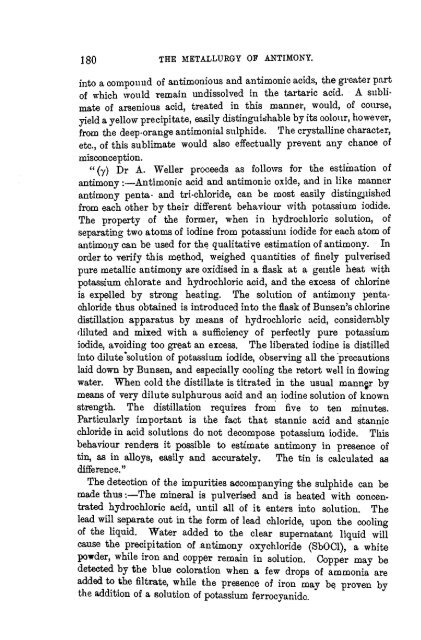antimony - Sciencemadness.org
antimony - Sciencemadness.org
antimony - Sciencemadness.org
Create successful ePaper yourself
Turn your PDF publications into a flip-book with our unique Google optimized e-Paper software.
130 THE METALLURGY OF ANTIMONY.<br />
into a compound of antimonious and antimonic acids, the greater part<br />
of which would remain undissolved in the tartaric acid. A sublimate<br />
of arsenious acid, treated in this manner, would, of course,<br />
yield a yellow precipitate, easily distinguishable by its colour, however,<br />
from the deep-orange antimonial sulphide. The crystalline character,<br />
etc., of this sublimate would also effectually prevent any chance of<br />
misconception.<br />
"(y) Dr A. Weller proceeds as follows for the estimation of<br />
<strong>antimony</strong> :—Antimonic acid and antimonic oxide, and in like manner<br />
<strong>antimony</strong> penta- and tri-chloride, can be most easily distinguished<br />
from each other by their different behaviour with potassium iodide.<br />
The property of the former, when in hydrochloric solution, of<br />
separating two atoms of iodine from potassium iodide for each atom of<br />
<strong>antimony</strong> can be used for the qualitative estimation of <strong>antimony</strong>. In<br />
order to verify this method, weighed quantities of finely pulverised<br />
pure metallic <strong>antimony</strong> are oxidised in a flask at a gentle heat with<br />
potassium chlorate and hydrochloric acid, and the excess of chlorine<br />
is expelled by strong heating. The solution of <strong>antimony</strong> pentachloride<br />
thus obtained is introduced into the flask of Bunsen's chlorine<br />
distillation apparatus by means of hydrochloric acid, considerably<br />
diluted and mixed with a sufficiency of perfectly pure potassium<br />
iodide, avoiding too great an excess. The liberated iodine is distilled<br />
into dilute 'solution of potassium iodide, observing all the precautions<br />
laid down by Bunsen, and especially cooling the retort well in flowing<br />
water. When cold the distillate is titrated in the usual manngr by<br />
means of very dilute sulphurous acid and an iodine solution of known<br />
strength. The distillation requires from five to ten minutes.<br />
Particularly important is the fact that stannic acid and stannic<br />
chloride in acid solutions do not decompose potassium iodide. This<br />
behaviour renders it possible to estimate <strong>antimony</strong> in presence of<br />
tin, as in alloys, easily and accurately. The tin is calculated as<br />
difference."<br />
The detection of the impurities accompanying the sulphide can be<br />
made thus:—The mineral is pulverised and is heated with concentrated<br />
hydrochloric acid, until all of it enters into solution. The<br />
lead will separate out in the form of lead chloride, upon the cooling<br />
of the liquid. Water added to the clear supernatant liquid will<br />
cause the precipitation of <strong>antimony</strong> oxychloride (SbOCl), a white<br />
powder, while iron and copper remain in solution. Copper may be<br />
detected by the blue coloration when a few drops of ammonia are<br />
added to the filtrate, while the presence of iron may be proven by<br />
the addition of a solution of potassium ferrocyanide.
















